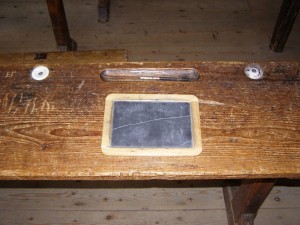11.12.13Do You Use “Slates” to Check For Understanding? Tell me more (Video)
I’m looking for some tales of Implementation as I write TLAC 2.0. The topic is what I call “slates.” It’s a small (but mighty) part of Checking for Understanding where students show you objective data on their work in unison in order for you to be able to more simply and quickly assess it. More on what it looks like—plus a video—below but wondering: Do you use this idea? Some different version of it? If so, what works, and how have you adapted it?
You can watch a good example of “slates” in this video of Uncommon’s Bryan Belanger reviewing a math problem his 8th grade math class completed.
As you can see, students bang their desks three times in sync to the words “rock, paper, scissors…” and then hold up one to four fingers in perfect unison to represent the answer they chose. As is obvious, this helps Bryan assess and re-teach quickly and efficiently.
Definition via me yammering: Up top, I defined “slates” as students showing you objective data on their work in unison in order for you to be able to more simply and quickly assess it. I’m going to parse that a bit. You probably circulate and observe what your students are doing all the time in class. That’s great practice, but it’s different form “slates.” In “slates” you don’t have to seek them out because they actively show you—they hold up their white boards with a problem written on them or hold up their novels to show you that they’ve marked up a key passage. I used the phrase objective data above because people sometimes think they’re doing “slates” when they ask for subjective data from students—“Hold up your fingers 1-4. One means ‘I get it’; four means ‘I’m lost.’” That to me is unreliable self-report. It may have other uses, but it’s not good for Checking for Understanding, and I don’t include it as part of “slates.” Finally, to be “slates,” the objective data has to be shown to you in unison so there’s no piggy-backing and changing answers.
So… do you use (objective!) hand signals from students? Do you use white boards? Something else that allows you to assess mastery quickly during class? If so tell me more. I’m looking to add some example to my chapter on CFU in TLAC 2.0.
And by the way, woot woot for Bryan B and his incredible math classes!


Color Cups
Each scholar has three colored cups stacked a green one (I understand), yellow cup ( I understand but have questions) and a red cup (Not there yet). Scholars will stack their cups with the one representing their reflections on the objective. This can be used as a quick in the moment data but not a true check for understanding.
thanks, steve. for what it’s worth i LIKE the idea you’re describing as it’s often useful to ask studnets to reflect on and agueg their own mastery. But i would not categorize as “slates” since the data is not objective but rather self-report. so as a categorization geek i’m not against it just saying it’s different from what i’m shooitng for here which is: “show me your answer”
Makes absolute sense I have seen teachers use playing cards assigned to specific multiple choice options similar to the use of rock, paper, scissors video shown. Scholars are expected to flip the card on their desk assigned to their choice of answer.
perfect. just the kind of stuff i’m looking for! thanks!
I do short, quick pop quizzes where students see one question on the screen at a time, with 4 multiple choice answers. Within a few seconds, they write the letter of their choice on a slate, nice and big, and then on my “show me!”, all slates go up.
Great example, Sylvia. Thanks.